The Smart Family’s Guide to ReStore Furniture Shopping
Creating a comfortable home for your family doesn't have to stretch your budget to its limits. Budget-conscious homeowners want to find quality...
5 min read
 ReStore Staff
:
4:12 PM on September 30, 2025
ReStore Staff
:
4:12 PM on September 30, 2025
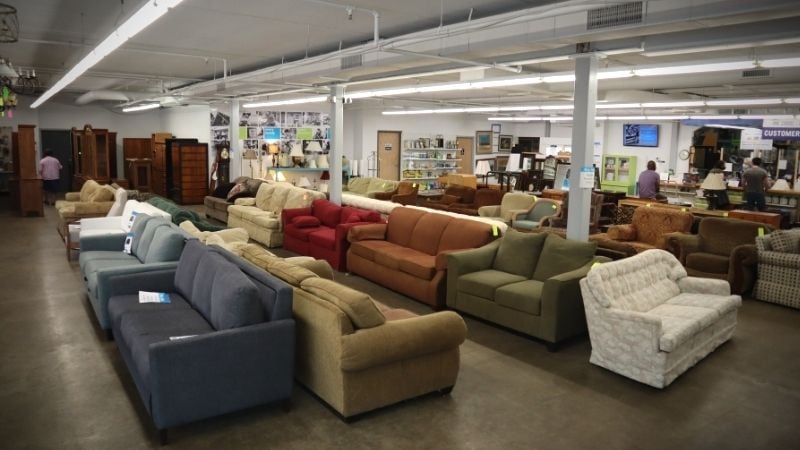
Shopping for secondhand furniture has never been more rewarding. You’re able to save money and find unique pieces with character, but you're also able to keep quality items in circulation and support your community.
However, while some pieces of furniture have years of life left in them, others might need a light (or heavy) makeover. How can you tell the difference? And how do you make sure you're getting pieces that will stand the test of time?

An interior view of ReStore home improvement outlet (Minneapolis location)
Whether you're a seasoned thrifter or new to secondhand shopping, these insider tips will help you navigate any resale shop, estate sale, or home improvement outlet.
Here are some tips from ReStore pros about how to buy secondhand furniture to make sure you're getting a bargain for your buck.
Eyeballing has its virtues, but trust the specifics to a tape measure. Whether you’re in the market for a bookshelf, chair, sofa, or end table, measure the height, width, and depth of the area you've picked out for it. Spending even a few bucks on a unique corner shelf could be a waste if it doesn’t fit into the corner you want to put it in.
Also, pick out a few different spots at home where you might want to put the piece. That way, you've got a fallback if you find something that looks perfect but is just a little bigger than your preferred spot.
There's nothing worse than finding out something doesn't work right AFTER you bring it home. A lot of secondhand furniture is sold as-is with no return policy, meaning you can't return it for any reason. To avoid this, test out furniture in the store. Sit on the couch to make sure it's comfortable for more than a few minutes. Open the dresser drawers to make sure the handles don't fall apart after a few uses. Peer in the cabinets and get a good look at the shelving inside.
Some resale and thrift stores have policies about testing out furniture in the store. Be sure to ask first to avoid any unfair "you break it, you buy it" policies.
It's hard to know how long a piece of furniture will last, but a good once-over can give you an idea. Use these criteria on how to buy secondhand furniture to separate "worth it" from "worthless":
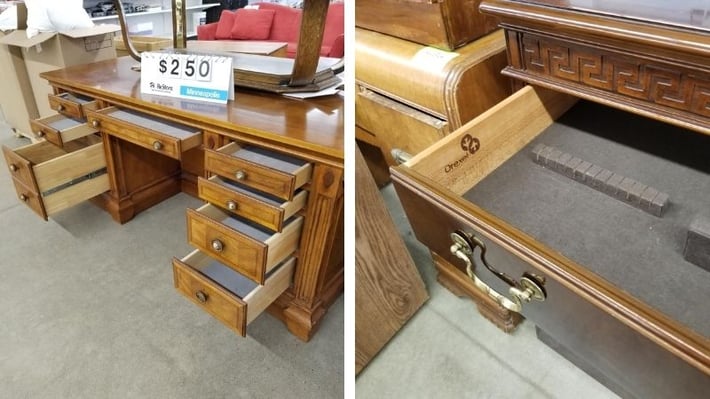
It may sound silly, but bad-smelling furniture might be a deal breaker, no matter how much you love it. It's hard to tell where a mystery smell came from, and even a light stench can take a long time to fade. For example, a faint trace of cigarette smoke on a piece sitting outdoors at a flea market will intensify once it's indoors (and it can soak into your clothes and other fabric in your home). New fabric, paint, and stain can do wonders, but once an odor sets into a piece of furniture, it's often permanent.
Make sure the backside of the furniture is in good condition (you'd be surprised how many people never give their second-hand furniture a 360 before bringing it home). Even if it's going to sit up against a wall, a quick check of the 'unseen' side can reveal deal-breakers like broken supports, holes in the back, and more.
You may absolutely love the look of a 60-inch-tall solid oak dresser you found, but you might want to go with something lighter weight if you want to get it home easily. (Furniture can be deceptively heavy, too – even little pieces can weigh a lot.) Before you lay down the cash, carefully lift or tip a piece of furniture in the store to get a quick idea of the kind of muscle you'll need to get it home.
Speaking of moving, make a plan to get it home from the store. If you have a pickup truck or trailer, you're in luck! If not, find out if you can rent one or borrow a friend's.
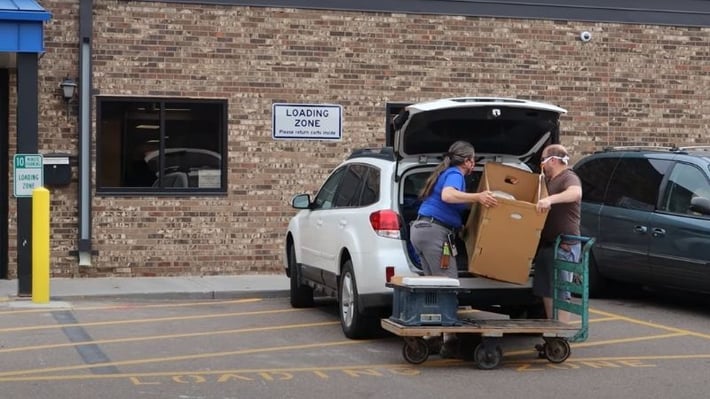
When buying secondhand furniture, it's important to picture the possibilities. You're rarely going to find a piece of furniture that doesn't need at least a little work. While you're thinking about how to fix up a piece of furniture, think about how you can make it yours while you're at it.
Again, try not to focus on cosmetic defects like light scratches on wood, off-kilter handles, or damaged casters. Think about how that pink pelican fabric would look much better as a sky blue canvas or how you could remove old inlay and paint over the crevice with a complementary color. If you open your mind to the possibilities of each piece, you'll find a lot to love while shopping for furniture.
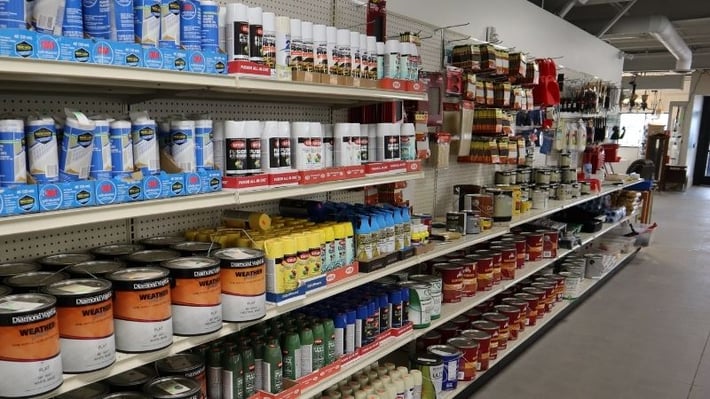
Paint and other materials you can use to spruce up used furniture (New Brighton ReStore)
Part of what makes buying secondhand furniture so compelling is the potential for sprucing it up – but you should factor in the cost of your work into the price you're willing to pay for the furniture itself. Add up the cost of the fabric, sandpaper, stain, handles, cushions, and anything else you'll need to fix it up, and add 10% for good measure. hen add the sum to the price on the tag. Consider THAT number the real cost of the furniture. (You can even factor in the cost of your labor, if you've got a number in mind.)
Shopping at a home improvement outlet like ReStore works a bit differently than other thrift stores. All donated furniture goes through a quality check before hitting the sales floor, which means you're less likely to encounter items with hidden damage or structural issues.
The inventory comes from a mix of sources: homeowners doing renovations, businesses with overstock or discontinued items, and contractors with surplus materials. This means you might stumble upon brand-new pieces right alongside gently used treasures. Since inventory changes constantly, shoppers often develop a routine of checking in regularly.
ReStore can also hold furniture purchases for up to three days. This takes the pressure off having to figure out pickup logistics on the spot. And when you're inspired to declutter after your shopping trip (it happens to the best of us!), use donation pickup services throughout the Twin Cities metro area, keeping the cycle of reuse going strong.
Every purchase at ReStore creates a ripple effect of positive change. Last year alone, ReStore diverted 5.9 million pounds of materials from landfills! When you choose to buy secondhand furniture, you're actively participating in the circular economy and reducing demand for new manufacturing that contributes to 45% of global greenhouse gas emissions.
Your furniture purchase also directly supports Twin Cities Habitat's mission to create, preserve, and promote affordable housing. Revenue from ReStore sponsors the building of five Habitat homes each year in the Twin Cities.
Consider donating your gently used furniture when you're ready for something new. You might get a tax deduction, and you’ll keep usable items in circulation and help stock the store for the next treasure hunter. ReStore recycles everything from metal to cardboard to paint.
To many people, buying used furniture is a little like going on a treasure hunt. Every day, team members at ReStore see hundreds of treasure hunters leave with their next big score. Whether you're searching for that perfect vintage dresser or looking to reduce your environmental footprint, your next ReStore visit could be the start of something special.
There's never been a better time to choose second-hand first. Join the hunt at ReStore.
Your gift unlocks bright futures! Donate now to create, preserve, and promote affordable homeownership in the Twin Cities.
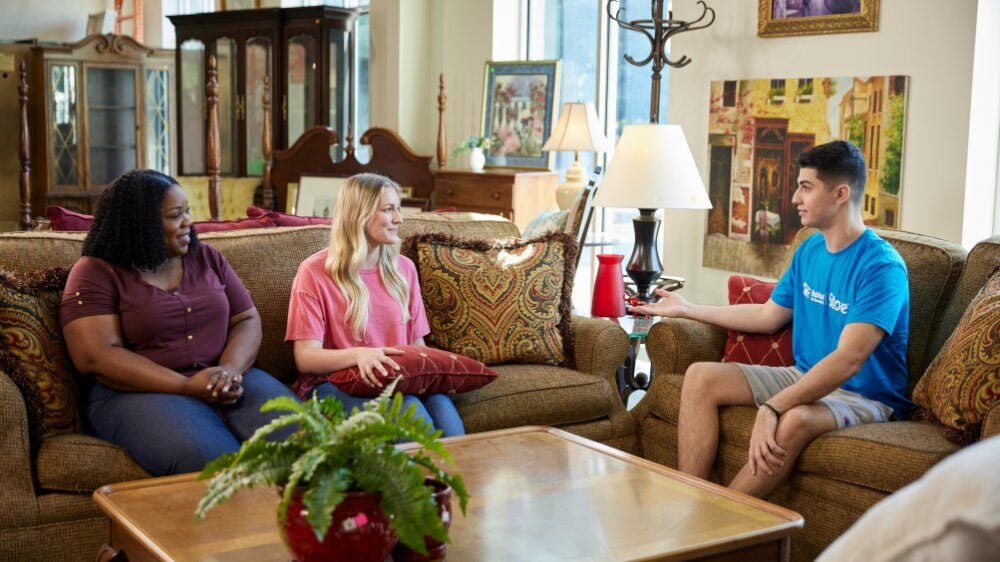
Creating a comfortable home for your family doesn't have to stretch your budget to its limits. Budget-conscious homeowners want to find quality...
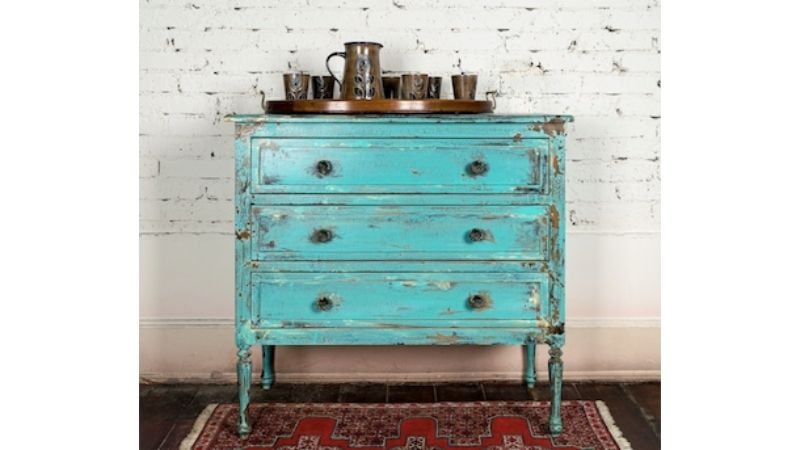
You don’t have to be a home décor expert to know that the rustic scheme rarely goes out of style, nor does the look of distressed antique furniture....
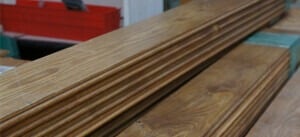
Did you know we sell new products at our two ReStore locations? It’s true—you can get new products at a lower price while supporting Twin Cities...